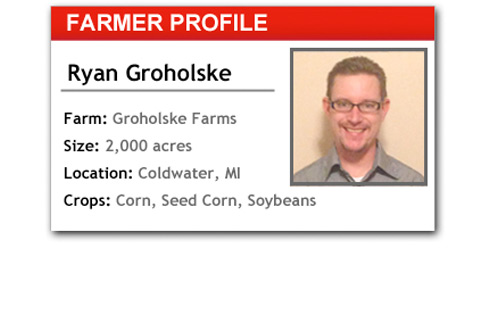 Ryan Groholske admits it. He’s a hoarder. But he’s not a candidate for a TLC Hoarding: Buried Alive episode. He hoards data from his precision farming system and mines it to help him manage his strip-tillage system and justify better crop insurance coverage for less cost.
Ryan Groholske admits it. He’s a hoarder. But he’s not a candidate for a TLC Hoarding: Buried Alive episode. He hoards data from his precision farming system and mines it to help him manage his strip-tillage system and justify better crop insurance coverage for less cost.
Groholske, who took the fourth-generation farming operation over from his father, Albert, in 2009, says they have been no-tilling since 1999 and started strip-tilling in the fall of 2012.
“We have a 16-row Soil Warrior with John Deere dry fertilizer rate controllers and a John Deere iSteer active implement guidance package,” he says “We use an RTK controller to get sub-inch accuracy.” A GreenStar 3 2630 monitor controls the tractor and strip-till/fertilizer rig.
In the spring, Groholske will apply 30 pounds per acre of nitrogen with another strip-till pass before planting. He plants with a 60-foot, 24-row DB60 Bauer Built planter bar with John Deere units mounted on 30-inch centers.
“Running with RTK is mandatory, since the strip-till unit is 16 rows and the planter is 24 rows. When we plant seed corn, we lock out one row unit and adjust our offset for 7.5 inches instead of 15 inches to get the correct row spacing,” he says. “Programming that offset was a hassle. I may turn it into a 26-row planter, but then the planter must be rewired. We might use an older seed monitor just for those two rows.”
He sprays with an AGCO SpraCoupe outfitted with a Raven Viper controller and AutoBoom shutoff to manage overlaps. The sprayer is controlled by a Trimble EZ Guide 500 with EZ-Steer.
Groholske variable-rates sidedressed nitrogen with a coulter cart and a Raven 440 rate controller. “It’s an older unit with serial ports that connects to a GS 2600 controller. It works great and was a less expensive option than the Deere rate controllers,” he says. “It took a specific wiring harness, then correctly setting the baud rate so the units would talk with each other.”
He uses a GS 2600 monitor in the John Deere 9870 combine to document yield and moisture data; the grain cart tractor also uses a GS 2600 to document grain coming in from the field to the dryer or storage.
What Farmers Want From You is a series of farmer profiles that examine the scope of precision farming tools individual farmers are using on their operation, along with the frustrations that can occur with adopting new technology and how dealers can alleviate those "points of pain" for farm customers. For the latest additions to the series, visit our What Farmers Want From You feed.
“I share some equipment and grain drying and storage with my cousin,” Groholske says. “Documenting what grain goes where helps us to make sure the drying and storage costs are fair.”
Point of Pain: Lagging Dealer Support
Groholske says working with various equipment dealers to get the Deere rate controllers on the strip-till unit working correctly was difficult.
“Our local dealerships were of little help. A technician at an Environmental Tillage Systems dealer in Minnesota helped trace it to a bad ground on one of the units,” he says.
In-season dealer support for precision equipment needs to get better in his area, Groholske says. Often, he’ll end up diagnosing and fixing problems with his precision equipment.
This helps him get more familiar with his technology, but at the same time, Groholske would like to be able to rely on his dealer for more support.
“When it’s Saturday night and you have problems, I am the first line of defense in getting it fixed. I use the manuals to get familiar with how the technology works with the equipment,” he says. “I spend as much time working with the monitor as I do working on the planter, and will test-run it all in early spring to make sure it’s all working together.”
Switching to RTK guidance solved signal issues he had with the GS3 units that use Wide Area Augmentation System (WAAS) technology. “The ground-based signal runs at 450 MHz instead of 900 MHz and recovers much faster from signal loss, which is key when you need the high level of accuracy I need to run equipment of different widths,” Groholske says.






